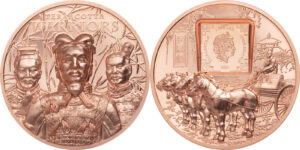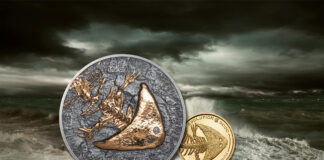On behalf of Cook Islands CIT Invest has created a small series dedicated to the tomb of China’s Emperor Qin Shihuang Di. The UNESCO World Heritage Site is guarded by an army of 8,000 terracotta warriors.

Terracotta Warriors in Silver
One side of the silver coins features the busts of three warriors of the Terracotta Army of the tomb of China’s Emperor Qin Shihuang Di one behind the other, in the background TERRACOTTA WARRIORS and a fine bamboo pattern.

The other side depicts the carriage of Emperor Qin Shihuang Di in a stylized Chinese landscape; in the left field, Terracotta Army in Chinese ideographs, in the middle the portrait of Queen Elizabeth II by Ian Rank-Broadley (initials: IRB); around it the name of the ruler, the issuing nation, the denomination and the year 2021; everything on a raised plate.

Terracotta Warriors in Gold
One side of the gold coins features two busts of three warriors of the Terracotta Army from the tomb of the Chinese Emperor Qin Shihuang Di one behind the other, in the background TERRACOTTA WARRIORS.
The other side features the portrait of Queen Elizabeth II by Ian Rank-Broadley (initials: IRB); around it the name of the ruler, the issuing nation, the denomination and the year.

Terracotta Warriors: A Dramatic Story
Qin Shihuang Di is considered the first emperor of a unified China. For the new superpower, he introduced a unified script, a unified currency, planned the expansion of the Great Wall of China and the road network that remained exemplary until modern times. And yet, in Europe, he isn’t mainly known as the creator of a powerful empire but as the man who was buried in one of the most impressive tombs known to mankind after his death on 10 September 210 BC. 8,000 terracotta warriors watch over his eternal rest.
More than 700,000 people sentenced to hard labor built the tomb while Qin Shihuang Di was still alive. Those who survived the compulsory labor were killed to prevent them from revealing to others the final resting-place of the world’s most powerful man. That’s why the Terracotta Army, which had fallen into oblivion, was only found in 1974 when farmers tried to dig a well. Anyone who has seen these life-size figures is fascinated by the realism of their design. And yet we can only imagine how realistic they used to look like, as only traces of the painting have survived. The Terracotta Army is an incomparable testimony to Chinese culture, and therefore the mausoleum of Emperor Qin Shihuang Di has been a UNESCO World Heritage Site since 1987.
By means of his four issues of the Terracotta Warriors series, CIT created an impressive tribute to the warriors of the Terracotta Army. Thanks to the ultra-high relief made possible by smartminting© technology, the coins reflect the monumental effect of the warriors. By means of delicate rose gold application on the central warrior of the 3-oz issue, CIT takes the color of terracotta into account. Additionally, a copper issue was created, a material that picks up the color of terracotta. In the Terracotta Warriors small series, Chinese technology of the 3rd century meets Western state-of-the-art minting technology of the 21st century: an impressive combination.
You can find more information on the Terracotta Warriors series on the CIT website.
If you want to understand the three-dimensionality of this coin, you have to watch these films:
To learn more about the tomb and its discovery watch this video:
You prefer a written article? Here you are! Study the Terracotta Warriors thoroughly at the Khan Academy.





